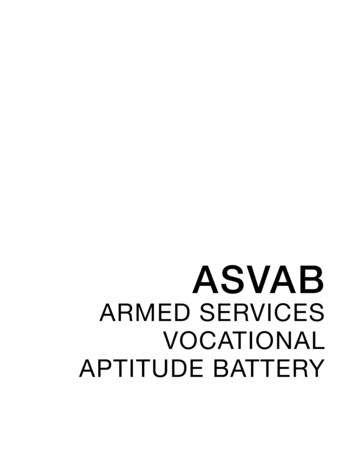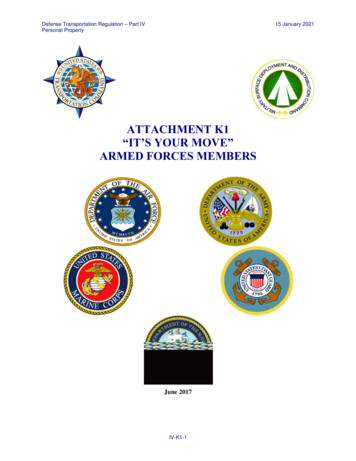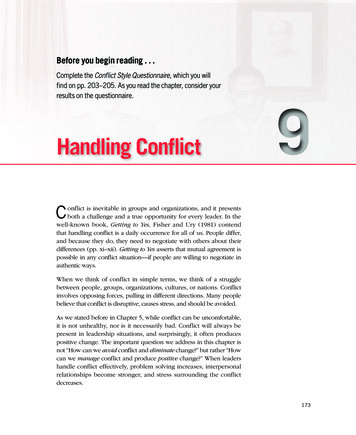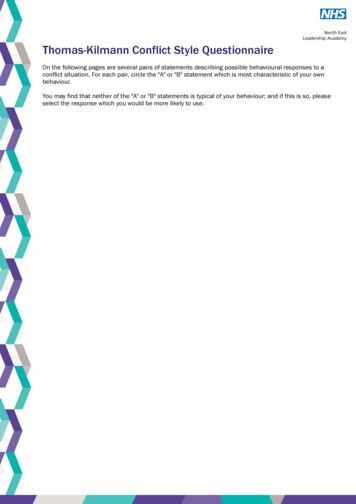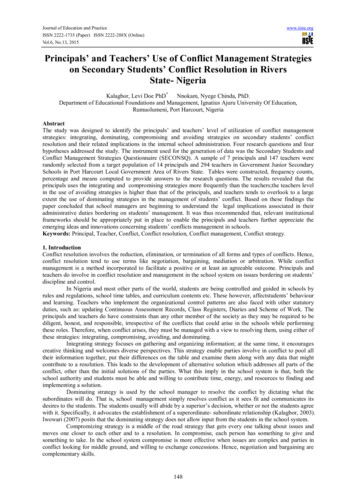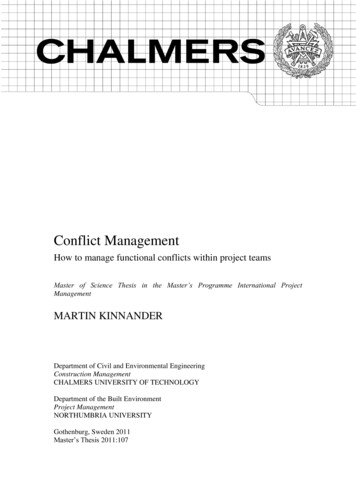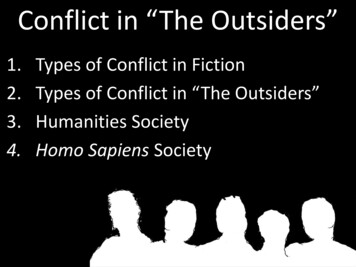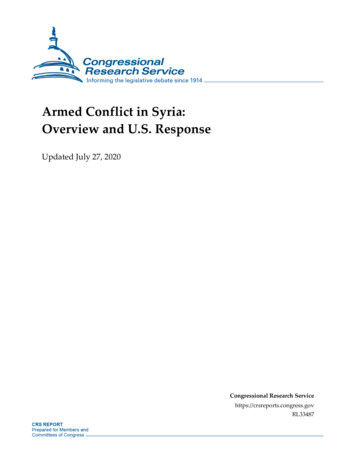
Transcription
Armed Conflict in Syria:Overview and U.S. ResponseUpdated July 27, 2020Congressional Research Servicehttps://crsreports.congress.govRL33487
SUMMARYArmed Conflict in Syria:Overview and U.S. ResponseAs of 2020, Syria faces growing economic instability and pockets of renewed politicalunrest, amid ongoing interventions by outside states and new public health challengesposed by the spread of the coronavirus (COVID-19). The government of SyrianPresident Bashar al Asad—backed by Russia, Iran, and Hezbollah—has recaptured mostareas formerly held by opposition forces but faces persistent challenges from fighterslinked to the Islamic State (IS, also known as ISIL/ISIS), as well as new protestsstemming from deteriorating economic conditions. U.S.-backed local forces haverecovered most territory formerly held by the Islamic State, but the group continues tomaintain a low-level insurgency.RL33487July 27, 2020Carla E. Humud,CoordinatorAnalyst in Middle EasternAffairsChristopher M. BlanchardSpecialist in MiddleEastern AffairsU.S. policy toward Syria since 2014 has prioritized counterterrorism operations against the Islamic State, whichsought to direct external attacks from areas under the group’s control in northeast Syria. Since 2015, U.S. forcesdeployed to Syria have trained, equipped, and advised local partners under special authorization from Congressand have worked primarily “by, with, and through” those local partners to retake nearly all areas formerly held bythe Islamic State. As of July 2020, about 600 U.S. troops remain in Syria, where they continue to support localpartner force operations against Islamic State remnants.In addition to counterterrorism operations against the Islamic State, the United States also has responded toSyria’s ongoing civil conflict by providing nonlethal assistance to Syrian opposition and civil society groups,encouraging diplomatic efforts to reach a political settlement to the civil war, and serving as the largest singledonor of humanitarian aid to Syria and regional countries affected by refugee outflows.The Trump Administration has described U.S. policy towards Syria as seeking (1) the enduring defeat of theIslamic State; (2) a political settlement to the Syrian civil war; and (3) the withdrawal of Iranian-commandedforces. Enduring defeat of ISIS. U.S.-backed partner forces re-captured the Islamic State’s finalterritorial strongholds in Syria in March 2019. However, U.S. military officials in 2020 assessedthat the group maintains a low-level insurgency in both Syria and Iraq and likely retains an intactcommand and control structure. The Defense Department has not disaggregated the costs ofmilitary operations in Syria from the overall cost of the counter-IS campaign in Syria and Iraq(known as Operation Inherent Resolve, OIR), which had reached 40.5 billion by September 30,2019.Political settlement to the conflict. The United States continues to advocate for a negotiatedsettlement between the government of Syrian President Bashar al Asad and Syrian oppositionforces in accordance with U.N. Security Council Resolution 2254 (which calls for the drafting ofa new constitution and U.N.-supervised elections). However, the Asad government has retakenmost opposition-held areas by force, thus reducing pressure on Damascus to negotiate. U.S.intelligence officials in 2019 assessed that Asad has little incentive to make significantconcessions to the opposition.Withdrawal of Iranian commanded forces. Administration officials state that the removal ofIran from Syria is a political rather than military goal, and have emphasized that the United Stateswill seek to counter Iranian activities in Syria primarily through the use of economic tools such assanctions. The United States has on occasion conducted strikes on Iranian-backed militias inSyria when such forces appeared to endanger U.S. or Coalition personnel.Congressional Research Service
Armed Conflict in Syria: Overview and U.S. ResponseExternal Players. A range of foreign states have intervened in Syria in support of the Asad government or Syrianopposition forces, as well in pursuit of their own security goals. Pro-Asad forces operating in Syria includeLebanese Hezbollah, Iran, and Russia. The United States and a range of regional and European states have attimes backed select portions of the Syrian opposition, while also expressing concern about reported ties betweensome armed opposition groups and extremist elements. Israel has acknowledged conducting over 200 militarystrikes in Syria, mostly targeting Hezbollah and/or Iranian targets. In addition, Turkey maintains military forces innorthern Syria as part of a broader campaign targeting Kurdish fighters.Humanitarian Situation. As of mid-2020, roughly half of Syria’s pre-war population remains internallydisplaced (6.2 million) or registered as refugees in neighboring states (5.6 million). The United States has directedmore than 11.3 billion toward Syria-related humanitarian assistance since FY2012, and Congress hasappropriated billions more for security and stabilization initiatives in Syria and neighboring countries. In July2020, the Security Council reauthorized cross border humanitarian aid into Syria for a period of one year. Thevote restricted aid to a single crossing point at Bab al Hawa following vetoes by Russia and China.Public Health. Syria has struggled to provide adequate testing for the novel COVID-19 virus, and the extent ofthe virus’s spread in the country is thought to exceed official health ministry counts. As of mid-July, Syriareported less than 500 confirmed cases of COVID-19, as compared to over 86,000 cases in neighboring Iraq, andover 267,000 cases in Iran. Syria contains numerous populations that are particularly vulnerable to infection,including thousands of internally displaced persons and detainees living in overcrowded conditions and lackingadequate access to sanitation facilities. Syria’s health care system also has been significantly degraded since thestart of the conflict in 2011 as a result of attacks by pro-regime forces on health care workers and infrastructure.Additional Domestic Challenges. Syria faces an economic crisis, with the value of the Syrian pound dropping torecord lows, and the cost of basic staples increasing by over 100% since 2019. In 2020, the Asad government alsohas confronted a resurgence of armed opposition in previously recaptured areas south of the capital, as well asgrowing criticism from both domestic and external allies.The 116th Congress has sought clarification from the Administration concerning its overall Syria policy, plans forthe withdrawal of U.S. military forces, the U.S role in ensuring a lasting defeat for the Islamic State, U.S.investments and approaches to postconflict stabilization, the future of Syrian refugees and U.S. partners insideSyria, and the challenges of dealing with the Iran- and Russia-aligned Asad government.Congressional Research Service
Armed Conflict in Syria: Overview and U.S. ResponseContentsBackground . 1Issues for Congress . 6Syria Provisions in FY2020 Defense and Foreign Operations Legislation . 9FY2020 National Defense Authorization Act (P.L. 116-92) . 9Further Consolidated Appropriations Act, 2020 (P.L. 116-94) . 10Consolidated Appropriations Act, 2020 (P.L. 116-93) . 11Select Syria-Related Legislation in the 116th Congress . 11Special Immigrant Status for U.S. Partner Forces . 11Military Developments . 12Turkish Incursion into Northern Syria . 12Islamic State: Ongoing Threats . 14Idlib Crisis. 16Political Developments. 20Non-State Governance Structures . 20Political Negotiations . 21The Geneva Process . 21The Astana Process . 23Humanitarian Situation. 24Cross-Border Aid Endangered . 24Vulnerable Areas . 25Public Health Developments . 28U.S. Policy. 29Trump Administration Statements on Syria Policy . 30U.S. Sanctions on Syria . 31U.S. Assistance to Vetted Syrian Groups . 32U.S. Military Operations; Train, Advise, Assist, and Equip Efforts . 32U.S. Military Presence in Syria. 32U.S. Repositions Forces in 2019 . 33Syria Train and Equip Program. 35FY2021 Defense Funding Request . 36U.S. Nonlethal and Stabilization Assistance . 37Outlook & Challenges . 41Consolidating Gains against the Islamic State . 41Preserving Relationships with Partner Forces . 42Countering Iran . 43Addressing Humanitarian Challenges in Extremist-Held Areas . 44Assisting Displaced Syrians . 44Preventing Involuntary Refugee Returns . 45Managing Reconstruction Aid . 46Supporting a Political Settlement to the Conflict. 46Monitoring Destabilizing Economic and Political Trends . 47Congressional Research Service
Armed Conflict in Syria: Overview and U.S. ResponseFiguresFigure 1. Syria: Map and Country Data . 2Figure 2. Syria Conflict 2011-2019 . 3Figure 3. Syria Areas of Influence 2020 . 4Figure 4. Syria Areas of Influence 2017 . 5Figure 5. Syria-Turkey Border . 13Figure 6. Idlib and its Environs . 19TablesTable 1. Evolution of U.S. Military Presence in Syria . 34Table 2. Syria Train and Equip Program: Appropriations Actions and Requests . 36Table 3. Nonlethal and Stabilization Funding for Syria . 39AppendixesAppendix. Syria Study Group Findings and Recommendations . 48ContactsAuthor Information. 49Congressional Research Service
Armed Conflict in Syria: Overview and U.S. ResponseBackgroundIn March 2011, antigovernment protests broke out in Syria, which has been ruled by the Asadfamily for more than four decades. The protests spread, violence escalated (primarily but notexclusively by Syrian government forces), and numerous political and armed opposition groupsemerged. In August 2011, President Barack Obama called on Syrian President Bashar al Asad tostep down. Over time, the rising death toll from the conflict, and the use of chemical weapons bythe Asad government, intensified pressure for the United States and others to assist theopposition. In 2013, Congress debated lethal and nonlethal assistance to vetted Syrian oppositiongroups, and authorized the latter. Congress also debated, but did not authorize, the use of force inresponse to an August 2013 chemical weapons attack.In 2014, the Obama Administration requested authority and funding from Congress to providelethal support to vetted Syrians for select purposes. The original request sought authority tosupport vetted Syrians in “defending the Syrian people from attacks by the Syrian regime,” butthe subsequent advance of the Islamic State organization from Syria across Iraq refocusedexecutive and legislative deliberations onto counterterrorism. Congress authorized a Departmentof Defense-led train and equip program to combat terrorist groups active in Syria, defend theUnited States and its partners from Syria-based terrorist threats, and “promote the conditions for anegotiated settlement to end the conflict in Syria.”In September 2014, the United States began air strikes in Syria, with the stated goal of preventingthe Islamic State from using Syria as a base for its operations in neighboring Iraq. In October2014, the Defense Department established Combined Joint Task Force-Operation InherentResolve (CJTF-OIR) to “formalize ongoing military actions against the rising threat posed byISIS in Iraq and Syria.” CJTF-OIR came to encompass more than 70 countries, and bolstered theefforts of local Syrian partner forces against the Islamic State. The United States also graduallyincreased the number of U.S. personnel in Syria from 50 in late 2015 to roughly 2,000 by 2017.President Trump in early 2018 called for an expedited withdrawal of U.S. forces from Syria,1 butsenior Administration officials later stated that U.S. personnel would remain in Syria to ensure theenduring defeat of the Islamic State. Then-National Security Advisor John Bolton also stated thatU.S. forces would remain in Syria until the withdrawal of Iranian-led forces.2 In December 2018,President Trump ordered the withdrawal of all U.S. forces from Syria, contributing to thesubsequent decision by Defense Secretary James Mattis to resign, and drawing criticism fromseveral Members of Congress. In early 2019, the White House announced that several hundredU.S. troops would remain in Syria.As the Islamic State and armed opposition groups relinquished territorial control inside Syria, theSyrian government and its foreign partners made significant military and territorial gains. TheU.S. intelligence community’s 2018 Worldwide Threat Assessment stated that the conflict had“decisively shifted in the Syrian regime’s favor, enabling Russia and Iran to further entrenchthemselves inside the country.”3 Coalition and U.S. gains against the Islamic State came largelythrough the assistance of Syrian Kurdish partner forces, but neighboring Turkey’s concerns aboutthose Kurdish forces emerged as a persistent challenge for U.S. policymakers. In 2019, Turkeylaunched a cross border military operation attempting to expel Syrian Kurdish U.S. partner forces1Remarks by President Trump on the Infrastructure Initiative, March 30, 2018; Remarks by President Trump andHeads of the Baltic States in Joint Press Conference, April 3, 2018.2 “Bolton: U.S. forces will stay in Syria until Iran and its proxies depart,” Washington Post, September 24, 2018.3 Worldwide Threat Assessment of the U.S. Intelligence Community, February 13, 2018.Congressional Research Service1
Armed Conflict in Syria: Overview and U.S. Responsefrom areas adjacent to the Turkish border. In conjunction with the operation, President Trumpordered the withdrawal of some U.S. forces from Syria and the repositioning of others in areas ofeastern Syria once held by the Islamic State.Territorial gains by the Syrian government have pushed remaining armed opposition forces(including Al Qaeda affiliates) into a progressively shrinking geographic space that is alsooccupied by roughly 3 million Syrian civilians. (Figure 3 and Figure 4 show how territory heldby Syrian opposition forces was significantly reduced between 2017 and 2020.) The remainingopposition-held areas of Idlib province in northwestern Syria have faced intensified and ongoingSyrian government attacks since 2019. Unrest in southern areas recaptured by the government in2020 suggests that security conditions nationwide may remain fluid.The U.N. has sponsored peace talks in Geneva since 2012, but it appears unlikely that the partieswill reach a political settlement that would result in a transition away from Asad. With manyarmed opposition groups weakened, defeated, or geographically isolated, military pressure on theSyrian government to make concessions to the opposition has been reduced. U.S. officials havestated that the United States will not fund reconstruction in Asad-held areas unless a politicalsolution is reached in accordance with U.N. Security Council Resolution 2254.4 In June 2020, theTrump Administration began implementing congressionally enacted sanctions on the Asadgovernment and its financial backers as part of a campaign to deny it revenue to compel Syrianleaders to end the war (see “U.S. Sanctions on Syria”). Some observers have warned of possibleunintended effects of new sanctions given fragile economic conditions prevailing in the country.5Figure 1. Syria: Map and Country DataSources: CRS using data from U.S. State Department; Esri; CIA, The World Factbook; and the United Nations.45State Department, “Joint Statement on the Ninth Anniversary of the Syrian Uprising,” March 15, 2020.“Will more Syria sanctions hurt the very civilians they aim to protect?” War on the Rocks, June 10, 2020.Congressional Research Service2
Armed Conflict in Syria: Overview and U.S. ResponseFigure 2. Syria Conflict 2011-2019Source: CRS.Note: For more information, see CRS In Focus IF11080, Syria Conflict Overview: 2011-2018, by Carla E. Humud.Congressional Research Service3
Armed Conflict in Syria: Overview and U.S. ResponseFigure 3. Syria Areas of Influence 2020As of May 25, 2020Sources: CRS using area of influence data from IHS Conflict Monitor, last revised May 25, 2020. All areas ofinfluence approximate and subject to change. Other sources include U.N. OCHA, Esri, and social media reports.Note: U.S. military officials have acknowledged publicly that U.S. forces are operating in select areas of easternSyria to train, advise, assist, and equip partner forces.Congressional Research Service4
Armed Conflict in Syria: Overview and U.S. ResponseFigure 4. Syria Areas of Influence 2017As of January 3, 2017Sources: CRS using area of influence data from IHS Conflict Monitor. All areas of influence approximate. Othersources include U.N. OCHA, Esri, and social media reports.Note: U.S. military officials have acknowledged publicly that U.S. forces are operating in select areas of easternSyria to train, advise, assist, and equip partner forces.Congressional Research Service5
Armed Conflict in Syria: Overview and U.S. ResponseIssues for CongressPrior to the 2019 Turkish military incursion and U.S. withdrawal decisions, the 116th Congresshad been considering the Administration’s FY2020 requests for defense and foreign aidappropriations, which presumed continued counterterrorism, train and equip, and humanitarianoperations in Syria. Members debated legislative proposals that would have extended andamended related authorities and made additional funding available to continue U.S. efforts,including stabilization programs. Following President Trump’s withdrawal and redeploymentdecisions, Congress enacted revisions to the underlying authority for U.S. military train and equipefforts in Syria and appropriated additional funds to continue related operations.Congress may further consider what, if any, revised defense and foreign assistance needs may beappropriate in connection with revised U.S. plans and any forthcoming changes to U.S. militarydeployments in Syria or in neighboring Iraq. Similarly, Members may consider how, if at all,Congress should increase, decrease, or reallocate defense, humanitarian, and stabilizationresources for FY2021 and what, if any, new or revised oversight mechanisms ought to beemployed.Specific issues for congressional consideration could include the following.U.S. military operations and authoritiesU.S. forces have operated inside Syria since 2015 pursuant to the 2001 and 2002 Authorizationsfor Use of Military Force (AUMF),6 despite ongoing debate about the applicability of theseauthorizations to current operations in Syria.7 In December 2018, President Trump declared theIslamic State “defeated,” raising questions about the authorities underlying a continued U.S.military presence in Syria. Defense and State Department officials continue to highlight theongoing threat posed by the Islamic State, including to the U.S. homeland.8 Islamic State attackscontinue in areas of eastern Syria, and oversight reporting suggests that Administration officialsbelieve the group could resurge if military pressure on its remnants lessens.9 Nevertheless, someobservers have argued that some U.S. military outposts in Syria (such as the U.S. garrison at AtTanf) appear primarily designed to stem the flow of Iranian-backed militias into Syria.10 In June2020, President Trump reported to Congress thatUnited States Armed Forces are conducting a systematic campaign of airstrikes and othernecessary operations against ISIS forces in Iraq and Syria and against al-Qa'ida in Syria. A6At a December 11, 2019, hearing before the House Armed Services Committee, Defense Secretary Esper stated that,“[ . ] we think we have sufficient authorities right now under the ’01 and ’02 AUMFs to conduct what we—to do whatwe need to do in Syria.” Similarly, Joint Chiefs of Staff Chairman Gen. Mark Milley stated, “[ . ] the ’01 AUMFallows us to conduct offensive strike operations against terrorists, Al Qaeda, etc. ISIS, we should all remember, is adirect derivative of Al Qaeda, and it is Al Qaeda in Iraq rebranded as ISIS.”7 During a December 11, 2019, hearing on U.S. Syria policy by the House Armed Services Committee, Rep. Smithstated, “ . I don't think it’s a good idea for us to be relying on the 2001 and 2002 AUMF in 2019. We could talk aboutwhat’s in the 2001 AUMF and how it applies to now. I think that thing has been stretched beyond all recognition. Butthe 2002 AUMF, it’s just ridiculous that we're still saying that this is an authority. I was here, and I voted for that. The2002 AUMF was to remove Saddam Hussein from power and stop the threat that he posed.”8 Joint Chiefs of Staff Chairman Gen. Mark Milley before the House Armed Services Committee, December 11, 2019.9 See reports (issued quarterly) by the Lead Inspector General for Operation Inherent Resolve.10 “U.S. Considering Plan to Stay in Remote Syrian Base to Counter Iran,” Foreign Policy, January 25, 2019.Congressional Research Service6
Armed Conflict in Syria: Overview and U.S. Responsesmall presence of United States Armed Forces remains in strategically significant locationsin Syria to conduct operations and secure critical petroleum infrastructure, in partnershipwith indigenous ground forces, against continuing terrorist threats emanating from Syria. 11Future of U.S.-SDF PartnershipFollowing the October 2019 Turkish incursion into northern Syria, the U.S.-backed SyrianDemocratic Forces (SDF) sought protection from the Asad government. U.S. SpecialRepresentative for Syria Engagement and the Special Envoy to the Global Coalition to DefeatISIS Ambassador James Jeffrey stated that the SDF and the Asad government reached “anagreement in some areas to coordinate.”12 In December 2019, senior U.S. military officialsacknowledged “dialogue” between the SDF and the Syrian military, but in 2020 have testifiedthat U.S. forces continue to conduct combined operations with the SDF.13 U.S. officials have notpublicly elaborated on the scale of coordination and/or dialogue between the Syrian military andthe SDF, or on how this may impact U.S. interactions with, or funding for, the group.Who are the Syrian Democratic Forces (SDF)?Since 2014, U.S. armed forces have partnered with a Kurdish militia known as the People’s Protection Units (YPG)to counter the Islamic State in Syria. In 2015, the YPG joined with other Syrian groups to form the SyrianDemocratic Forces (SDF), comprising the SDF’s leading component. Turkey considers the YPG to be the Syrianbranch of the PKK (Kurdistan Workers’ Party), a U.S.-designated terror group that has waged a decades-longinsurgency in Turkey. Ankara has strongly objected to U.S. cooperation with the SDF. U.S. officials haveacknowledged YPG-PKK ties, but generally consider the two groups distinct.14The Syrian Arab Coalition. Roughly 50% of the SDF is composed of ethnic Arab forces, according to U.S.officials;15 this component sometimes is referred to as the Syrian Arab Coalition (SAC). In 2018, the U.S. militaryassessed that the SAC probably is unable to conduct counter-IS operations on its own without the support of theSDF’s primary component, the YPG.16 In 2018, the Defense Intelligence Agency (DIA) described the SAC as “apatchwork of Arab tribal militias, military councils, and former opposition groups recruited by the YPG initially asa ‘symbolic’ move to help attract western support and training.”17 In 2020, DIA assessed that the YPG maintainscontrol over leadership and decision-making positions within the SDF and SDC-led institutions, demonstrating an“unwillingness to share power with Arabs, even in the Arab-majority regions of the northeast where Arab fightersprobably represent a majority of the SDF’s front line forces.”1811President Donald Trump, Letter to the Speaker of the House of Representatives and President Pro Tempore of theSenate, June 9, 2020.12 Ambassador James Jeffrey, State Department Special Representative for Syria Engagement and Special Envoy to theGlobal Coalition to Defeat ISIS, before the Senate Foreign Relations Committee, October 22, 2019.13 Defense Under Secretary for Policy John Rood before the Senate Armed Services Committee, December 5, 2019;CENTCOM Commander Gen. McKenzie before the Senate Armed Services Committee, March 12, 2020.14 See, for example, “US admissions of PYD-PKK links growing,” Anadolu Agency, February 15, 2018.15 Ambassador Jeffrey before the Senate Foreign Relations Committee, October 22, 2019.16 2018 assessment referenced in “Lead Inspector General for Operation Inherent Resolve, Quarterly Report to theUnited States Congress,” October 1, 2019-December 31, 2019, p. 43.17 Ibid.18 Lead Inspector General for Operation Inherent Resolve Quarterly Report to the United States Congress January 1,2020 – March 31, 2020.Congressional Research Service7
Armed Conflict in Syria: Overview and U.S. ResponseSecurity of U.S. Forces in SyriaSyrian government forces, with the support of Russia, expanded their operations and presence insome areas of eastern Syria evacuated by U.S., Coalition, and SDF forces in 2019. The expandedpresence of Syrian government forces in these areas may increase the potential for interactionsbetween remaining U.S. personnel and Syrian or Russian forces, with uncertain implications forforce protection and potential conflict. The Syrian government continues to refer to U.S. forces asoccupiers and has warned that “resistance” forces might target U.S. personnel.19 In July 2020,CENTCOM Commander Gen. McKenzie stated, “Over time, [Syrian President] Bashar al-Assadis probably going to turn to the east and increase pressure on us, and we’ll deal with that as ithappens.”20Syrian officials have specifically called for the United States to end what they
including thousands of internally displaced persons and detainees living in overcrowded conditions and lacking adequate access to sanitation facilities. Syria’s health care system also has been significantly degraded since the start of the conflict in 2011 as a result of attacks by pro
